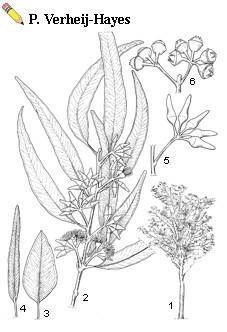Record Number
3510
PROSEA Handbook Number
5(1): Timber trees; Major commercial timbers
Taxon
Eucalyptus tereticornis J.E. Smith
This article should be read together with the article on the genus: Eucalyptus in the Handbook volume indicated above in this database.
This article should be read together with the article on the genus: Eucalyptus in the Handbook volume indicated above in this database.
Protologue
Spec. bot. New Holland 1: 41 (1795).
Synonyms
Eucalyptus subulata Cunn. ex Schauer (1843), Eucalyptus insignis Naudin (1891), Eucalyptus umbellata (Gaertner) Domin (1928) non Desf.
Vernacular Names
Forest red gum (En).
Distribution
Southern Papua New Guinea, eastern Queensland, New South Wales and Victoria, Australia. Cultivated in Papua New Guinea, on a large scale in India, less extensively in other tropical countries.
Uses
The wood is used for heavy construction, railway sleepers, piles, poles and as a mining timber. It is also used for fuelwood, charcoal, pulpwood, hardboard and particle board. The species is used for reforestation. Eucalyptus tereticornis is a major source of pollen and nectar; the nectar has a caramel flavour.
Observations
A large tree of up to 50 m tall, bole straight, up to 200 cm in diameter, bark smooth throughout, white, grey or grey-blue; juvenile leaves first opposite, then alternate, ovate, slightly discolorous, adult leaves alternate, narrowly lanceolate to lanceolate, 10-20 cm 1-2.5 cm, acuminate, petiole 13-24 mm long; inflorescence simple, umbels 7-11-flowered; flower buds conical, operculum conical; fruit subglobular to ovoid, 5-7 mm 4-8 mm, with 4 or 5 strongly exserted valves. Eucalyptus tereticornis grows scattered in open forest on alluvial flats up to 1000 m altitude.
Image
 | Eucalyptus tereticornis J.E. Smith - 1, habit; 2, flowering branch; 3, juvenile leaf; 4, adult leaf; 5, flower buds; 6, fruits |
Selected Sources
[63a]Boland, D.J. et al., 1984. Forest trees of Australia. Industrial Research Organisation, Melbourne. 687 pp.
[85]Brooker, M.I.H. & Kleinig, D.A., 1990. Field guide to Eucalypts. 2 volumes. Incata Press, Melbourne & Sydney. 299 & 428 pp.
[130]Chew, T.K., 1980. Growth of Eucalyptus species in Peninsular Malaysia. Malaysian Forester 43: 8–15.
[232]Flora of Australia (various editors), 1981–. Australian Government Publishing Service, Canberra.
[322a]Hillis, W.E. & Brown, A.G., 1978. Eucalypts for wood production. Griffin Press, Adelaide. 434 pp.
[343]Jacobs, M.R., 1981. Eucalypts for planting, 2nd ed. FAO Forestry Series No 11. FAO, Rome. 677 pp.
[359]Keating, W.G. & Bolza, E., 1982. Characteristics, properties and uses of timbers. Vol. 1. South-East Asia, Northern Australia and the Pacific. Inkata Press Proprietary Ltd., Melbourne, Sydney & London. 362 pp.
[540]Penfold, A.R. & Willis, J.L., 1961. The eucalypts: botany, cultivation, chemistry and utilisation. Hill, London. 551 pp.
[85]Brooker, M.I.H. & Kleinig, D.A., 1990. Field guide to Eucalypts. 2 volumes. Incata Press, Melbourne & Sydney. 299 & 428 pp.
[130]Chew, T.K., 1980. Growth of Eucalyptus species in Peninsular Malaysia. Malaysian Forester 43: 8–15.
[232]Flora of Australia (various editors), 1981–. Australian Government Publishing Service, Canberra.
[322a]Hillis, W.E. & Brown, A.G., 1978. Eucalypts for wood production. Griffin Press, Adelaide. 434 pp.
[343]Jacobs, M.R., 1981. Eucalypts for planting, 2nd ed. FAO Forestry Series No 11. FAO, Rome. 677 pp.
[359]Keating, W.G. & Bolza, E., 1982. Characteristics, properties and uses of timbers. Vol. 1. South-East Asia, Northern Australia and the Pacific. Inkata Press Proprietary Ltd., Melbourne, Sydney & London. 362 pp.
[540]Penfold, A.R. & Willis, J.L., 1961. The eucalypts: botany, cultivation, chemistry and utilisation. Hill, London. 551 pp.
Author(s)
C.C.H. Jongkind
Correct Citation of this Article
Jongkind, C.C.H., 1993. Eucalyptus tereticornis J.E. Smith. In: Soerianegara, I. and Lemmens, R.H.M.J. (Editors): Plant Resources of South-East Asia No 5(1): Timber trees; Major commercial timbers. PROSEA Foundation, Bogor, Indonesia. Database record: prota4u.org/prosea

All texts are licensed under a Creative Commons Attribution-Noncommercial-Share Alike 3.0 Netherlands License
This license does not include the illustrations (Maps,drawings,pictures); these remain all under copyright.